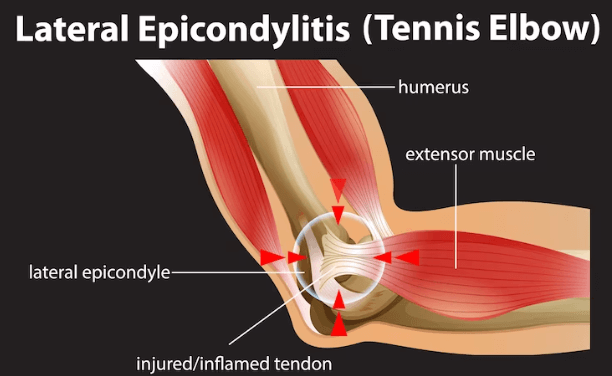Tennis elbow, also called lateral epicondylitis, is a pain in the forearm’s tendons to our elbow. It is caused by overuse or repeated strenuous activity such as banging or knocking the elbow.
What are the causes of tennis elbow?
Despite the name, playing tennis only causes 5% of tennis elbow cases. Tennis elbow is caused by any repetitive, forceful motion that pulls on the tendon and muscle around your elbow. During tennis, gripping the racquet too tightly while hitting the ball puts more stress on the tendons, and this can cause rapid wear and tear. This also applies to other sports such as squash, badminton, softball, baseball, bowling etc. Other activities that can cause tennis elbow are: cutting wood, carpentry, playing instruments, painting, plumbing, butchering, cooking, gardening, farming, dentistry, etc.
What are the symptoms?
Tennis elbow is usually self-diagnosable. Its symptoms include:
- Pain on the outside of the elbow (lateral side). The pain is triggered by wrist movements that tug your elbow tendons.
- Other symptoms are difficulty moving your arm sometimes, having a lump or bulge on it, loosening of grip, pain or difficulty in doing everyday tasks or finding that the area around your elbow is swollen.
You must see a doctor if symptoms continue for over a week. The doctor may even diagnose tennis elbow for you through tests like MRI and X-Ray for arthritis and electromyography to detect discrepancies in nerve function.
How is it treated?
Tennis elbow is treated through physical therapy, rest and medications. You must stop the activity triggering the tennis elbow and get rest—medications to ease swelling and pain. A splint or a brace might also be given to help your armrest. Ultrasound treatment can break up scar tissue and increase blood flow for better healing.
How do I prevent it?
Tennis elbow can be prevented by warm-up exercises to ease the intensity of repetitive movements. Strength training and flexibility exercises for the elbow and wrist are also necessary precautions. The tears caused by the tennis elbow can last a while and cause discomfort in lifting and gripping if not treated immediately. Listening to your body is a must. Use proper equipment to reduce stress on tendons.
When you consult a doctor, ask what activity caused your tennis elbow, what treatment is best recommended for your case, how you should change your current routine to maximise your healing procedure and what complications you should watch out for.
How can Sancheti help you?
Though tennis elbow can easily be treated, getting a doctor’s advice would help you in the long run. Visit Sancheti or our website learn more about our expert team.








0 comments on “Tennis elbow: What to expect?”